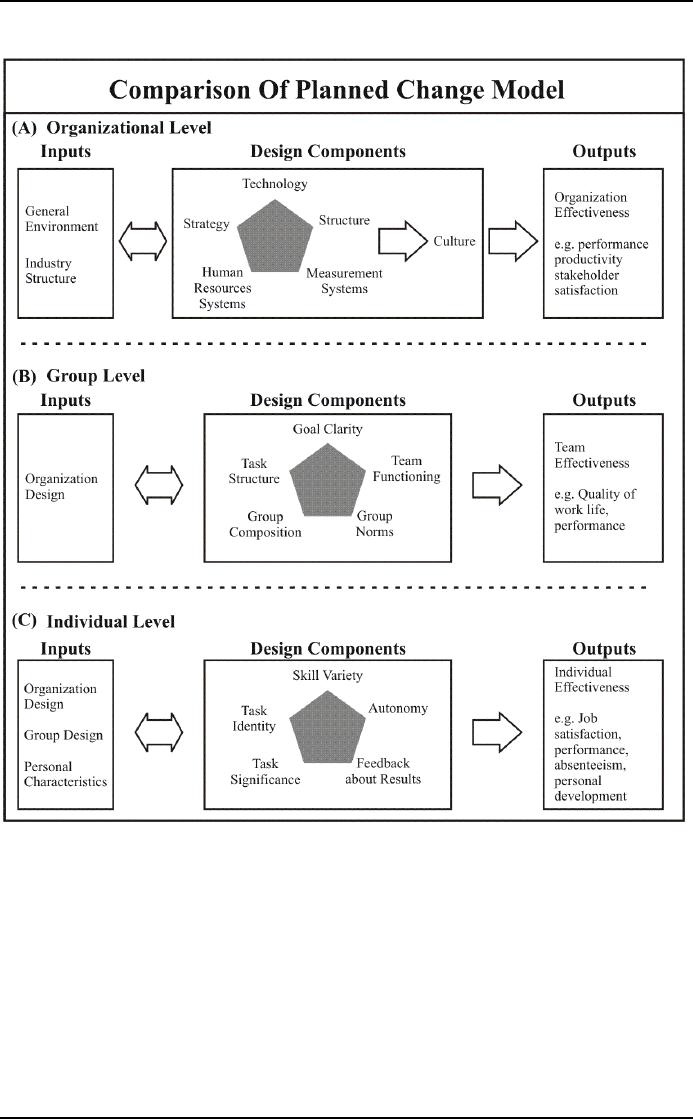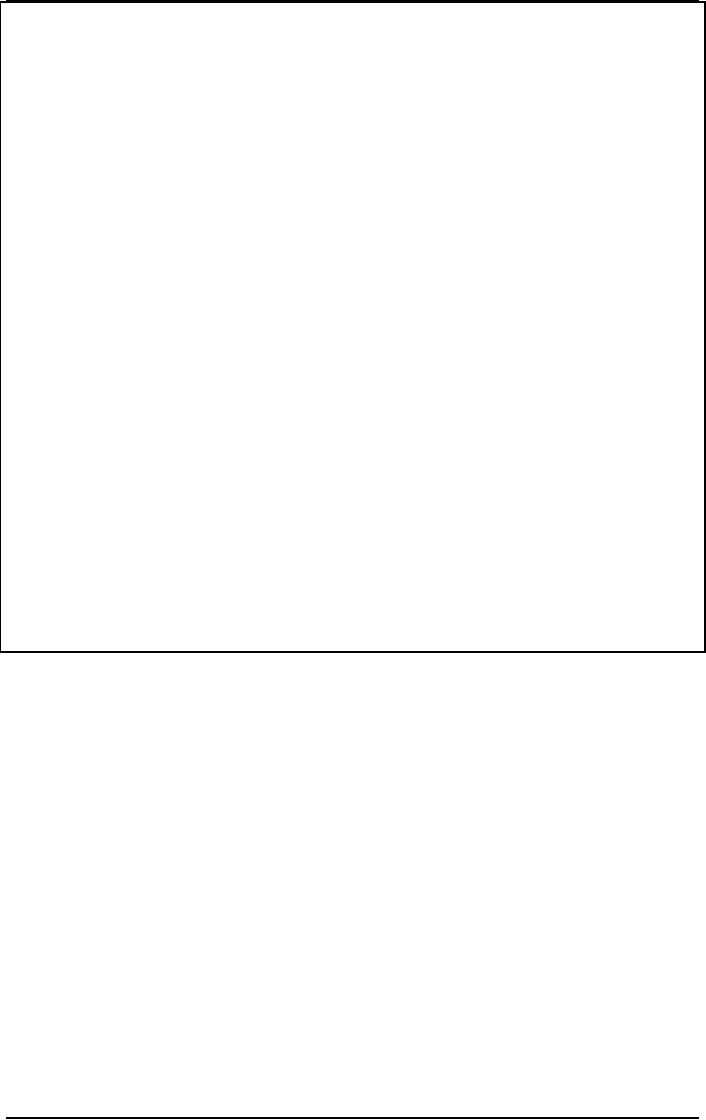 |
Diagnosing Groups and Jobs:Design Components, Outputs |
| << Diagnosing Organizations:Outputs, Alignment, Analysis |
| Diagnosing Groups and Jobs:Design Components, Fits >> |

Organization
Development MGMT
628
VU
Lesson
18
Diagnosing
Groups and Jobs
Diagnosis
is the second major phase in the model of planned
change. Based on open-systems
theory, a
comprehensive
diagnostic framework for organization-, group-,
and job-level systems was
discussed. The
organization-level
diagnostic model was elaborated
and applied. After the organization level, the
next two
levels
of diagnosis are the group
and job. Many large
organizations have groups or
departments that are
themselves
relatively large. Diagnosis of large
groups can follow the
dimensions and relational
fits
applicable
to organization-level diagnosis. In essence,
large groups or departments
operate much like
organizations,
and their functioning can be
assessed by diagnosing them as
organizations.
Small
departments and groups, however,
can behave differently from
large organizations and so they
need
their
own diagnostic models to reflect
those differences. In the first
section, we discuss the diagnosis
of
work
groups. Such groups
generally consist of a relatively small
number of people working face-to-face
on
a
shared task. Work groups
are prevalent in all sizes of
organizations. They can he relatively
permanent and
perform
an ongoing function, or they can be
temporary and exist only to
perform a certain task or to
make
a
specific decision.
Finally,
we describe and apply a diagnostic model
of individual jobs--the smallest
unit of analysis in
organizations.
An individual job is constructed to
perform a specific task or
set of tasks. How jobs
are
designed
can affect individual and organizational
effectiveness.
Group-Level
Diagnosis:
Figure
24 replicates the comprehensive model
discussed earlier but
highlights the group- and
individual-
level
models. It shows the inputs, design
components, outputs, and relational fits
for group-level diagnosis.
The
model is similar to other popular
group-level diagnostic models,
such as Hackman and Morris's
task
group
design model, McCaskey's framework for
analyzing groups, and
Ledford, Lawler, and
Mohrman's
participation
group design model.
Inputs:
Organization
design is clearly the major input to
group design. It consists of the
design components
characterizing
the larger organization within which the
group is embedded: technology,
structure,
measurement
systems, and human resources
systems, as well as organization culture.
Technology can
determine
the characteristics of the group's task;
structural systems can
specify the level of coordination
required
among groups. The human
resources and measurement
systems, such as performance
appraisal
and
reward systems, play an important
role in determining team functioning.
For example,
individually
based
performance appraisal and
reward systems tend to
interfere with team
functioning because
members
may
be more concerned with maximizing
their individual performance to the
detriment of team
performance.
Collecting information about the group's
organization design context can
greatly improve the
accuracy
of diagnosis.
Design
Components:
Figure
24 (B) shows that groups
have five major components:
goal clarity, task
structure, group
composition,
group functioning, and
performance norms.
Goal
clarity involves how well the
group understands its
objectives. In general, goals should be
moderately
challenging;
there should be a method for
measuring, monitoring, and feeding
back information about
goal
achievement;
and the goals should be clearly
understood by all members.

Organization
Development MGMT
628
VU
Figure
24: Comprehensive Model for
Diagnosing Organizational
Systems
Task
structure is concerned with
how the group's work is
designed. Task structures
can vary along two
key
dimensions;
coordination of members' efforts
and regulation of their task
behaviors. The
coordination
dimension
involves the degree to which
group tasks are structured
to promote effective interaction
among
group
members. Coordination is important in
groups performing interdependence
tasks, such as
surgical
teams
and problem-solving groups. It is
relatively unimportant, however, in groups
composed of members
who
perform independent tasks, such as a
group of telephone operators or
salespeople. The regulation
dimension
involves the degree to which members
can control their own
task behaviors and be
relatively
free
from external controls such as
supervision, plans, and
programs. Self-regulation generally
occurs when
members
can decide on such issues as
task assignments, work
methods, production goals,
and membership.
Composition
concerns the membership of groups.
Members can differ on a number of
dimensions having
relevance
to group behavior. Demographic variables,
such as age, education,
experience, and skills
and
abilities,
can affect how people behave
and relate to each other in
groups. Demographics can
determine
whether
the group is composed of people having
task-relevant skills and knowledge,
including

Organization
Development MGMT
628
VU
interpersonal
skills. People's internal
needs also can influence
group behaviors. Individual
differences in
social
needs can determine whether
group membership is likely to be
satisfying or stressful.
Group
functioning is the underlying basis of
group life. How members
relate to each other is
important in
work
groups because the quality of
relationships can affect task
performance. In some groups,
for example
interpersonal
competition and conflict
among members result in
their providing little
support and help
for
each
other. Conversely groups may
become too concerned about
sharing good feelings and
support and
spend
too little time on task
performance. In organization development considerable
effort has been
invested
to help work group members
develop healthy interpersonal relations, including
ability and a
willingness
to share feelings and
perceptions about members' behaviors so
that inter-personal problems
and
task difficulties can he
worked through and resolved.
Group functioning therefore involves
task-related
activities,
such as giving and seeking
information and elaborating,
coordinating, and evaluating
activities;
and
the group-maintenance function, which is
directed toward holding the
group together as a cohesive
team
and includes encouraging, harmonizing,
compromising, setting standards, and
observing.
Performance
norms are member beliefs
about how the group should perform
its task and include
acceptable
levels of performance. Norms derive
from interactions among members
and serve as guides
to
group
behavior. Once members agree
on performance norms, either implicitly
or explicitly, then
members
routinely
perform tasks according to
those norms. For example,
members of problem-solving groups
often
decide
early in the life of the group
that decisions will be made
through voting; voting then
becomes a
routine
part of group task
behavior.
Outputs:
Group
effectiveness has two
dimensions: performance and
quality of work life.
Performance is measured in
terms
of the group's ability to control or
reduce costs, increase
productivity, or improve quality.
This is a
"hard"
measure of effectiveness. In addition,
effectiveness is indicated by the group
member's quality of
work
life. It concerns work
satisfaction, team cohesion,
and organizational commitment.
Fits:
The
diagnostic model in Figure 24(B) shows
that group design components
must fit inputs if groups
are to
be
effective in terms of performance and the
quality of work life.
Research suggests the following
fits
between
the inputs and design
dimensions:
1.
Group
design should be congruent with the
larger organization design. Organization
structures
with
low differentiation and high
integration should have work
groups that are composed of
highly
skilled
and experienced members
performing highly interdependent tasks.
Organizations with
differentiated
structures and formalized human
resources and information
systems should spawn
groups
that have clear,
quantitative goals and
support standardized behaviors.
Although there is
little
direct research on these fits, the
underlying rationale is that congruence
between organization
and
group designs support
overall integration within the
company. When group designs
are not
compatible
with organization designs, groups
often conflict with the organization.
They may
develop
norms that run counter to organizational
effectiveness, such as occurs in
groups
supportive
of horseplay, goldbricking, and
other counterproductive
behaviors.
2.
When
the organization's technology results in interdependent
tasks, coordination among
members
should
be promoted by task structures,
composition, performance norms, and
group functioning.
Conversely
when technology permits independent
tasks, the design components should
promote
individual
task performance. For
example, when coordination is
needed, task structure
might
physically
locate related tasks together;
composition might include members with
similar
interpersonal
skills and social needs;
performance norms would
support task-relevant
interactions;
and
healthy interpersonal relationships would be
developed.
3.
When
the technology is relatively uncertain and requires
high amounts of information
processing
and
decision making, group task
structure, composition, performance
norms, and group
functioning
should promote self-regulation. Members should
have the necessary freedom,
information,
and skills to assign members
to tasks, to decide on production
methods, and to set
performance
goals. When technology is relatively
certain, group designs should
promote
standardization
of behavior, and groups should be
externally controlled by supervisors,
schedules,
and
plans. For example, when self-regulation
is needed, task structure
might be relatively flexible
and
allow the interchange of members
across group tasks;
composition might include
members
with
multiple skills, interpersonal
competencies, and social
needs; performance norms
would
support
complex problem solving; and efforts
would be made to develop healthy
interpersonal
relations.

Organization
Development MGMT
628
VU
Application
3: Top-Management Team at Ortiv Glass
Corporation
The
Ortiv Glass Corporation
produces and markets plate
glass for use primarily in
the construction and
automotive
indulines. The multiplant company
has been involved in OD for
several years and
actively
supports
participative management practices and
employee involvement programs.
Ortiv's organization
design
is relatively organic, and the manufacturing
plants are given freedom and
encouragement to develop
their
own organization designs and
approaches to participative management. It
recently put together a
problem-solving
group made up of the top-management
team at its newest
plant.
The
team consisted of the plant
manager and the managers of the
five functional departments
reporting to
him:
engineering (maintenance), administration,
human resources, production,
and quality control.
In
recruiting
managers for the new plant,
the company selected people with
good technical skills
and
experience
in their respective functions. It also
chose people with some
managerial experience and a
desire
to
solve problems collaboratively, a
hallmark of participative management. The
team was relatively new,
and
members had been working
together for only about five
months.
The
team met formally for
two hours each week to
share pertinent information
and to deal with plant
wide
issues
affecting all of the departments, such as
safety procedures, interdepartmental
relations, and
personnel
practices.
Members described these
meetings as informative but
often chaotic in terms of
decision making.
The
meetings typically started
late as members straggled in at
different times. The
latecomers generally
offered
excuses about more pressing
problems occurring elsewhere in the
plant. Once started, the
meetings
were
often interrupted by "urgent"
phone messages for various
members, including the plant
manager, and
in
most cases the recipient would
leave the meeting hurriedly to
respond to the call.
The
group had problems arriving
at clear decisions on particular issues.
Discussions often rambled
from
topic
to topic, and members tended
to postpone the resolution of problems to
future meetings. This led
to
a
backlog of unresolved issues,
and meetings often lasted
far beyond the two-hour limit.
When group
decisions
were made, members often
reported problems in their implementation.
Members typically
failed
to
follow thorough on agreements,
and there was often
confusion about what had actually
been agreed
upon.
Everyone expressed dissatisfaction with
the team meetings and their
results.
Relationships
among team members were
cordial yet somewhat strained,
especially when the team
was
dealing
with complex issues in which
members had varying opinions
and interests. Although the
plant
manager
publicly stated that he
wanted to hear all sides of
the issues, he often interrupted the
discussion or
attempted
to change the topic when members
openly disagreed in their
views of the problem. This
interruption
was typically followed by an
awkward silence in the group. In many
instances when a solution
to
a pressing problem did not
appear forthcoming, members either moved
on to another issue or they
informally
voted on proposed options, letting
majority rule decide the outcome.
Members rarely
discussed
the
need to move on or vote; rather, these
behaviors emerged informally
over time and became
acceptable
ways
of dealing with difficult
issues.
Analysis:
Application
3 presents an example of applying
group-level diagnosis to a top-management
team engaged in
problem
solving.
The
group is having a series of ineffective
problem-solving meetings. Members
report a backlog of
unresolved
issues, poor use of meeting
time, lack of follow through
and decision implementation, and
a
general
dissatisfaction with the team
meeting. Examining group
inputs and design components
and how
the
two fit can help explain the
causes of those group
problems.
The
key issue in diagnosing
group inputs is the design of the
larger organization within which the
group is
embedded.
The Ortiv Glass
Corporation's design is relatively
differentiated. Each plant is allowed to
set up
its
own organization design. Similarly,
although no specific data
are given, the company's
technology,
structure,
measurement systems, human
resources systems, and culture
appear to promote flexible
and
innovative
behaviors at the plant level. Indeed,
freedom to innovate in the manufacturing plants is
probably
an
outgrowth of the firm's OD activities and
participative culture.
In
the case of decision-making groups
such as this one, organization design
also affects the nature of
the
issues
that are worked on.
The team meetings appear to
be devoted to problems affecting all of
the
functional
departments. This suggests
that the problems entail high
interdependence among the
functions;
consequently
high coordination among
members is needed to resolve
them. The team meetings
also seem
to
include many issues that are
complex and not easily
solved, so there is probably a relatively
high amount
of
uncertainty in the technology or work process.
The causes of the problems or
acceptable solutions are
not
readily available. Members must
process considerable information
during problem solving,
especially
when
there are different
perceptions and opinions
about the issues.

Organization
Development MGMT
628
VU
Diagnosis
of the team's design components
answers the following
questions:
1.
How
clear are the group's
goals? The
team's goals seem relatively
clear: they are to
solve
problems.
There appears to be no clear agreement,
however on the specific problems to be
addressed. As a
result,
members come late because
they have "more
pressing"
problems needing
attention.
2.
What
is the group's task structure?
The
team's task structure
includes face-to-face
interaction
during the weekly meetings.
That structure allows
members from
different
functional
departments to come together physically
to share information and to
solve
problems
mutually affecting them. It facilitates
coordination of problem solving
among the
departments
in the plant. The structure
also seems to provide team
members with the freedom necessary
to
regulate
their task behaviors in the
meetings. They can adjust
their behaviors and interactions to
suit the
flow
of the discussion and problem-solving
process.
3.
What
is the composition of the group?
The
team is composed of the plant
manager and
managers
of five functional departments.
All members appear to have
task-relevant skills and
experience,
both
in their respective functions
and in their managerial
roles. They also seem to be
interested in solving
problems
collaboratively. That shared
interest suggests that
members have job-related social
needs and
should
feel relatively comfortable in group problem-solving
situations.
4.
What
are the group's performance
norms? Group
norms cannot be observed directly
but must
be
inferred from group
behaviors. The norms involve
member beliefs about how
the group should
perform
its task, including
acceptable levels of performance. A
useful way to describe norms
is to list
specific
behaviors that complete the
sentences "A good group
member should...." and "its
okay to...."
Examination
of the team's problem-solving behaviors
suggests the following performance
norms are
operating
in the example:
·
"It's
okay to come late to team
meetings."
·
"It's
okay to interrupt meetings with
phone messages."
·
"It's
okay to leave meetings to respond to
phone messages."
·
"It's
okay to hold meetings longer than
two hours."
·
"A
good group member should not
openly disagree with others'
views."
·
"It's
okay to vote on
decisions."
·
"A
good group member should be cordial to
other members."
·
"It's
okay to postpone solutions to immediate
problems."
·
"It's
okay not to follow through on previous
agreements."
5.
What
is the nature of team
functioning in the group?
The
case strongly suggests
that
interpersonal
relations are not healthy on the
management team. Members do
not seem to
confront
differences openly. Indeed, the
plant manager purposely intervenes when
conflicts
emerge.
Members feel dissatisfied with the
meetings, but they spend
little time talking about
those
feelings.
Relationships are strained,
but members fail to examine
the underlying causes.
The
problems facing the team can
now be explained by assessing how
well the group design fits
the inputs.
The
larger organization design of Ortiv is
relatively differentiated and promotes
flexibility and innovation
in
its
manufacturing plants. The firm
supports participative management, and
the team meetings can be
seen
as
an attempt to implement that approach at the
new plant. Although it is
too early to tell whether the
team
will
succeed, there does not
appear to be significant incongruity
between the larger organization design
and
what
the team is trying to do. Of
course, team problem solving
may continue to be ineffective,
and the
team
might revert to a more autocratic
approach to decision making. In
such a case, a serious
mismatch
between
the plant management team
and the larger company would
exist, and conflict between
the two
would
likely result.
The
team's issues are highly
interdependent and often uncertain, and
meetings are intended to resolve
plant
wide
problems affecting the various functional
departments. Those problems
are generally complex
and
require
the members to process a great
deal of information and
create innovative solutions. The
team's task
structure
and composition appear to be the nature
of team issues. The
face-to-face meetings help
to
coordinate
problem solving among the department
managers, and except for the
interpersonal skills,
members
seem to have the necessary
task-relevant skills and
experience to drive the
problem-solving
process.
There appears, however, to be a conflict in the
priority between the problems to be
solved by the
team
and the problems faced by
individual managers.
More
important, the key difficulty
seems to be a mismatch between the
team's performance norms
and
interpersonal
relations and the demands of the
problem-solving task. Complex, interdependent
problems
require
performance norms that
support sharing of diverse
and often conflicting kinds of
information. The

Organization
Development MGMT
628
VU
norms
must encourage members to
generate novel solutions and to
assess the relevance of
problem-solving
strategies
in light of new issues.
Members need to address
explicitly how they are
using their knowledge
and
skills
and how they are weighing
and combining members'
individual contributions.
In
our example, the team's
performance norms fail to support complex
problem solving; rather, they
promote
a problem-solving method that is
often superficial, haphazard,
and subject to external
disruptions.
Members'
interpersonal relationships reinforce adherence to the
ineffective norms. Members do
not
confront
personal differences or dissatisfactions
with the group process. They
fail to examine the very
norms
contributing to their problems. In this
case, diagnosis suggests the
need for group
interventions
aimed
at improving performance norms
and developing healthy interpersonal
relations.
Table of Contents:
- The Challenge for Organizations:The Growth and Relevance of OD
- OD: A Unique Change Strategy:OD consultants utilize a behavioral science base
- What an “ideal” effective, healthy organization would look like?:
- The Evolution of OD:Laboratory Training, Likert Scale, Scoring and analysis,
- The Evolution of OD:Participative Management, Quality of Work Life, Strategic Change
- The Organization Culture:Adjustment to Cultural Norms, Psychological Contracts
- The Nature of Planned Change:Lewin’s Change Model, Case Example: British Airways
- Action Research Model:Termination of the OD Effort, Phases not Steps
- General Model of Planned Change:Entering and Contracting, Magnitude of Change
- The Organization Development Practitioner:External and Internal Practitioners
- Creating a Climate for Change:The Stabilizer Style, The Analyzer Style
- OD Practitioner Skills and Activities:Consultant’s Abilities, Marginality
- Professional Values:Professional Ethics, Ethical Dilemmas, Technical Ineptness
- Entering and Contracting:Clarifying the Organizational Issue, Selecting an OD Practitioner
- Diagnosing Organizations:The Process, The Performance Gap, The Interview Data
- Organization as Open Systems:Equifinality, Diagnosing Organizational Systems
- Diagnosing Organizations:Outputs, Alignment, Analysis
- Diagnosing Groups and Jobs:Design Components, Outputs
- Diagnosing Groups and Jobs:Design Components, Fits
- Collecting and Analyzing Diagnostic information:Methods for Collecting Data, Observations
- Collecting and Analyzing Diagnostic information:Sampling, The Analysis of Data
- Designing Interventions:Readiness for Change, Techno-structural Interventions
- Leading and Managing Change:Motivating Change, The Life Cycle of Resistance to Change
- Leading and managing change:Describing the Core Ideology, Commitment Planning
- Evaluating and Institutionalizing Organization Development Interventions:Measurement
- Evaluating and Institutionalizing Organization Development Interventions:Research Design
- Evaluating and Institutionalizing Organization Development Interventions
- Interpersonal and Group Process Approaches:Group Process
- Interpersonal and Group Process Approaches:Leadership and Authority, Group Interventions
- Interpersonal and Group Process Approaches:Third-Party Interventions
- Interpersonal and Group Process Approaches:Team Building, Team Building Process
- Interpersonal and Group Process Approaches:Team Management Styles
- Organization Process Approaches:Application Stages, Microcosm Groups
- Restructuring Organizations:Structural Design, Process-Based Structures
- Restructuring Organizations:Downsizing, Application Stages, Reengineering
- Employee Involvement:Parallel Structures, Multiple-level committees
- Employee Involvement:Quality Circles, Total Quality Management
- Work Design:The Engineering Approach, Individual Differences, Vertical Loading
- Performance Management:Goal Setting, Management by Objectives, Criticism of MBO
- Developing and Assisting Members:Career Stages, Career Planning, Job Pathing
- Developing and Assisting Members:Culture and Values, Employee Assistance Programs
- Organization and Environment Relationships:Environmental Dimensions, Administrative Responses
- Organization Transformation:Sharing the Vision, Three kinds of Interventions
- The Behavioral Approach:The Deep Assumptions Approach
- Seven Practices of Successful Organizations:Training, Sharing Information